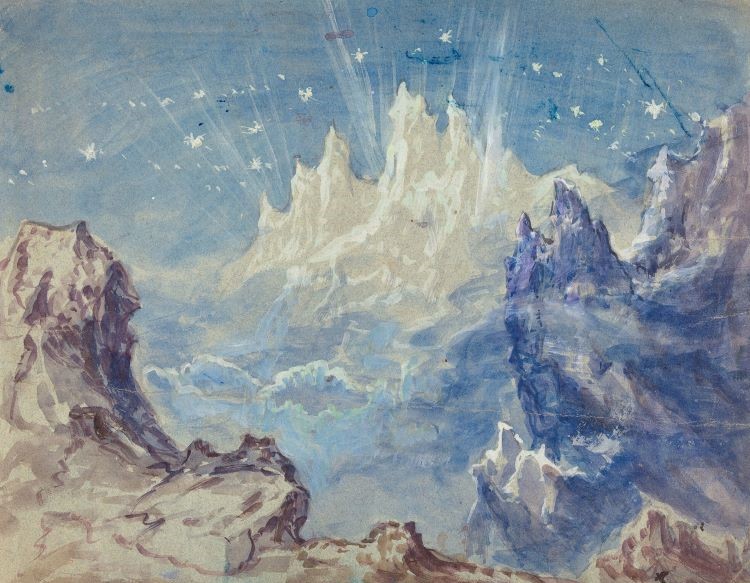Among contemporary authors who delve into Tibetan Buddhist philosophy, one of the most intriguing, in my opinion, is Jay Garfield, a professor at the Central University of Tibetan Studies, Melbourne University, and a visiting scholar at the prestigious Harvard Divinity School. Garfield's most commendable characteristic, in addition to his indisputable thematic expertise, is his clear ability to express philosophically complex concepts in a language that is secular and familiar to Western readers. I drew inspiration for this article from Garfield's works on the central theme of the Middle Way; the perception of reality and the absence of the self. Unfortunately, many of his works are poorly translated into Italian. For completeness, I also drew from: Empty Words, Engaging Buddhism, and The Fundamental Wisdom of the Middle Way.
Construction of the Illusory Self
An important consideration, in my opinion, is the lesser role that so-called Western philosophy gives to Eastern philosophy, particularly Buddhist philosophy. I believe this is rooted in academic training until recent decades, which distinctly separates Western philosophy from Eastern, perhaps introducing a bias of superiority towards the former. Additionally, the difficulty of studying Eastern philosophy due to the lack of valid translations until a few years ago contributes to this. It is of extreme usefulness and richness to draw inspiration from both philosophies without fearing whether some have become the foundation for religious constructs. There is no reason why Plato should be considered superior to Nagarjuna except due to the ignorance of Western scholars inevitably more exposed to Plato than Nagarjuna. From my perspective, I choose not to differentiate between ancient Western philosophers, Christian philosophers, Buddhists, Hindus, or Sufis. I believe each is a manifestation of human thought aimed at asking the same questions, seeking the same answers, and ultimately finding a path to liberation from suffering. The ability to draw inspiration from different philosophies is a uniqueness of our times. Never before has it been possible to freely access Eastern philosophy. Not only in terms of text accessibility but also due to the increasingly marked absence of preconceptions or closures in the minds of the philosophy-studying community. I find it enlightening to examine a sutra in the light of the Gospel, or vice versa. I find it enlightening to study the meditation of the desert fathers in the light of Vipassana meditation. Even the Buddhist view of reality can be seen in the light of Western science. It is a richness that has become a reality only recently, and this is wonderful.
In Buddhism, there tends to be a distinction between the schools of thought related to the three turnings of the Dharma wheel, which correspond to the three major teachings given by the Buddha. The first is that of the Four Noble Truths, the second is the absence of a self in things and phenomena, and the third is the explanation of the absence of a self through the three Natures: imputed, dependent on causes (dependent origination), and emptiness. In other words, the three Natures are the ways in which things appear. The first way is the conventional, so-called dualistic way, where objects seem to exist externally, or there seems to be an object and a subject perceiving it. The second way is that of an existence due to a series of causes and conditions, or an existence due to dependent arising. This is a step beyond dualism because it doesn't assign inherent existence to external objects but only existence dependent on causes and conditions. The third nature is that of emptiness, where the object exists only conventionally and not ultimately. This means that objects are not intrinsically existent; they are empty of intrinsic existence and have only an imputed existence.
Humans have the characteristic of perceiving reality as existing out there, as if it had intrinsic existence. This is simply how it appears to our consciousness. To realize that it is not so requires meticulous philosophical analysis. This innate perception is what Buddhism calls ignorance, and I like to imagine it as something akin to the original sin in the Christian tradition.
A note of caution here because if we set the philosophical goal of realizing emptiness, that is, deeply understanding that the ultimate nature of things is devoid of intrinsic existence, there is a risk of considering everything as an unworthy illusion to be lived. Paradoxically, regarding human beings as empty of intrinsic existence risks distancing us from compassion and the desire for the happiness of all sentient beings. And this is the underlying assumption of our motivation. This risk is referred to as nihilism. On the contrary, it is possible to understand the emptiness of intrinsic existence and, at the same time, comprehend that even though things are empty of intrinsic existence, they do not appear in this way. To engage with the world, it is necessary to do so through the illusory existence of things. To love, study, and understand emptiness, it is necessary to do so through the conventional nature of things; otherwise, there would be no books, teachers, and nothing else. This is the essence of the Middle Way, halfway between believing completely that things exist intrinsically (which everyone inherently believes) and the extreme opposite, namely, that nothing exists.
In Buddhism or mysticism in general, there is an aspiration to come into direct contact with the ultimate nature of things through contemplation and transcendence. It is essential to emphasize this aspect because studying the philosophy of how things appear might seem to go in the exact opposite direction. This is a crucial point because those studying Buddhism are generally drawn to contemplation and transcendence and may become discouraged in the face of profound philosophical reasoning. In other words, the study of philosophy could reinforce the ego and the perception of intrinsic existence in ourselves (perhaps boasting about our intelligence) or the concepts under study. However, that direct transcendental knowledge cannot be divorced from logical reasoning. It is the metaphor of the raft, where we need a very concrete means that must be abandoned once we reach a direct understanding. Direct understanding means that we no longer have to reason about it; at that point, perception simply appears to us as it truly is. A simple example of direct perception is the taste of an apple; we can study or philosophize about it, but once the apple is bitten, it becomes viscerally clear without any need for further studies. Another analogy is the firmament. The ancient Greeks imagined the stars as openings in the celestial vault through which light penetrated. This conventional belief did not hinder the study of the sky, the prediction of eclipses, and the celestial motion; it was useful even though not true. Once it is understood that the stars are actually luminous entities in space, that conventional belief simply collapses, and although the firmament appears the same to us, our awareness is different, deeper.
Realizing how things truly exist, that they have no intrinsic existence, means uprooting the root cause of suffering. In the Second Noble Truth, it is explicitly stated that craving and aversion for things are the cause of suffering. In reality, these two arise from something deeper that encompasses both: ignorance (mentioned in the Second Noble Truth). Ignorance of what? Ignorance of understanding how things truly exist, that things exist only conventionally and not intrinsically. Some prefer the word "confusion" to ignorance. Our minds are confused about how things truly exist, and this generates the desire to possess or avoid them. This is the root of suffering. To arrive at this understanding, a profound philosophical study is necessary until our perception of reality is clear, not just intellectually but perceptively. Only at this point can we abandon philosophy as a useful means to reach this understanding. It will be like seeing the firmament as it is, without the need to intellectually deconstruct the ignorant vision of the ancient Greeks: holes in the celestial vault.
Experientially understanding what the self is and what it is not is crucial in Buddhist philosophy because the self is precisely the object of negation, something we must experience and refute. For this reason, it is essential to have a clear understanding of the self and the manifestations that seem like a self but are not. It is evident that we are dealing with something that exists in one way but appears in another, and this inevitably complicates matters. Something that appears in one way but exists in another is called an illusion, like a mirage, for example. One must be cautious because illusions have the characteristic of persisting as such even after discovering that they are illusions. The mirage of water on scorching asphalt persists even when we know it's an illusion. This aspect is crucial and even reassuring because it provides awareness that understanding the illusory nature of the self does not make it disappear into a nihilistic view of the world. On the contrary, I continue to perceive the illusion but am aware that it is not true. This is beneficial because it is through the illusion of the self that we can interact with the world. A similar analogy can be made with money. It is not difficult to understand that the value of banknotes is purely conventional and illusory, but adhering to that illusion allows us to operate in the world.
Summarizing: the self must be clearly identified as the object of negation. Given the illusory nature of the self, it does not disappear.
People, understood as the roles we play upon an apparent self, exist by virtue of relationships and interdependence with others. Our profession, with which we identify, depends on others recognizing us as such. We are children because we have parents, friends because we have friends; ultimately, we are individuals in relation to everyone else. We exist as people in relation rather than as separate selves isolated from everything. The "we" precedes the "me." It is not possible to exist as individuals without others recognizing us as such. If we face the world as isolated selves, where others matter less or not at all, and we matter less or not at all to others, it is a rather distorted and exclusive view that creates a perceived reality made up of islands.
Discovering that there is no independent self can be frightening, and we might feel like we are losing ourselves if we find out that there is no self. But it's the exact opposite. As long as we believe in having a self, we are separated from everything, and life lacks meaning. When we discover that this self is just an illusion, we realize that we exist as individuals, interrelated and part of a matrix composed of other people that sustains the essence of being a person. In this relational dimension, life gains meaning, and others become as important as oneself because it is through them that one can be a person. The illusion of the self is a genuine obstacle to happiness and the meaning of life. It is not only an illusion of existence but also an illusion that it will bring us happiness.



